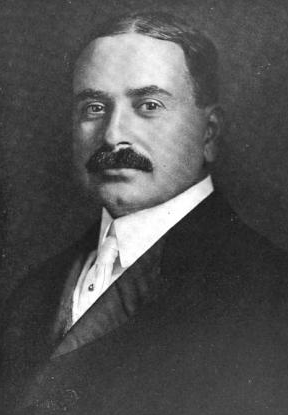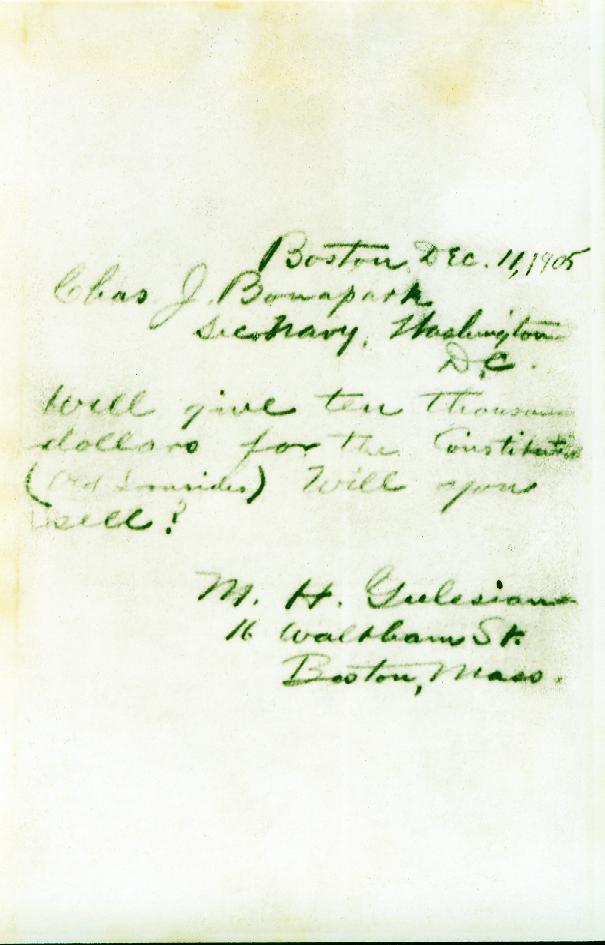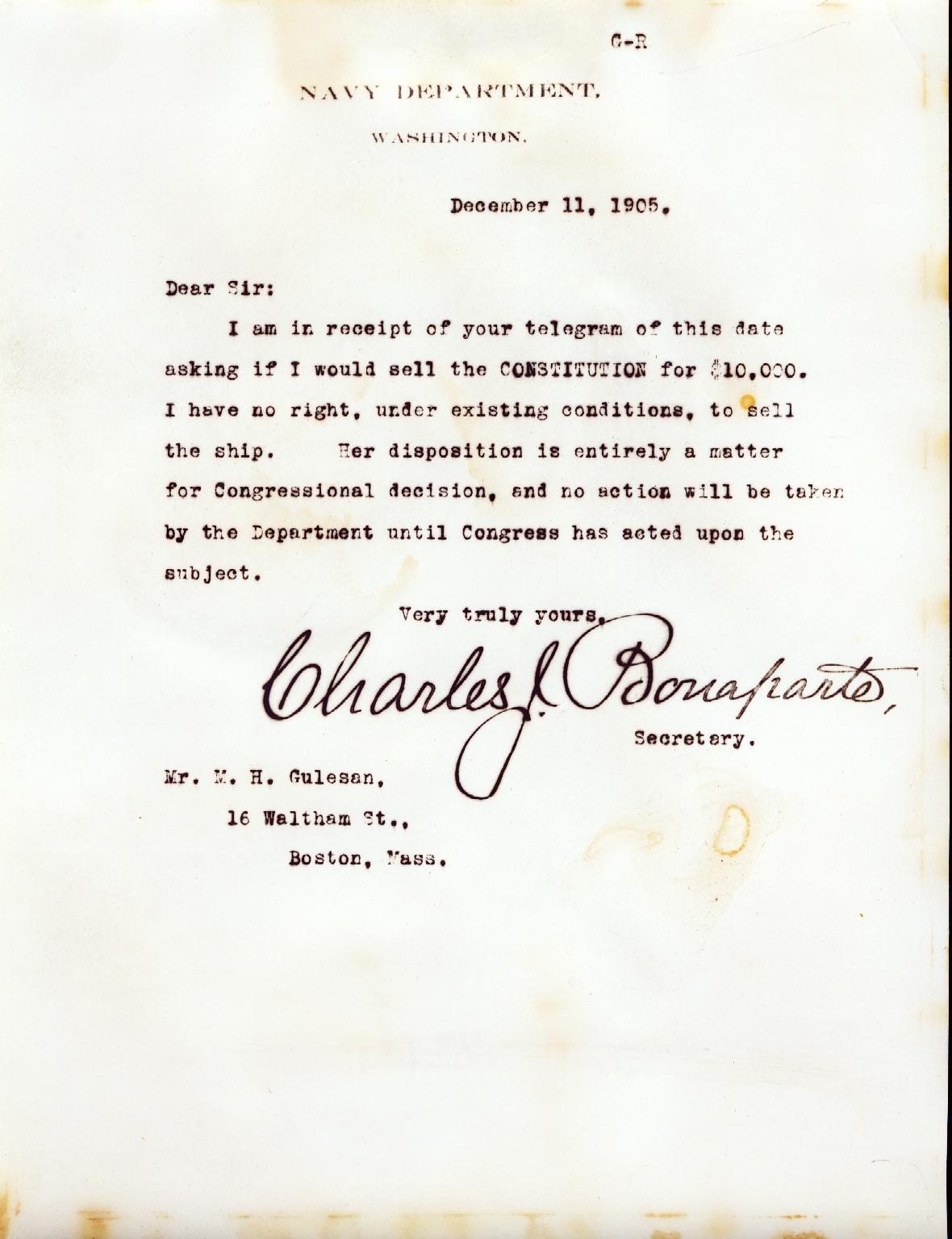Boston businessman Moses Gulesian didn’t know much about USS Constitution when he sat down to read his evening newspaper on December 10, 1905. What he learned about the venerable ship in the pages of the paper that night compelled him to pen the following telegram to the Secretary of the Navy the next morning:
“Will give ten thousand dollars for the Constitution (Old Ironsides). Will you sell?”
Gulesian’s startling offer spoke volumes about the man making it, but also spoke to the condition and likely fate of the ship at the time. USS Constitution had returned to Boston in 1897 amid great fanfare surrounding the centennial of its launch, but the navy failed to make a long-term plan for the ship or provide the funding needed to maintain it. Seven years later, no real restoration effort had occurred on the ship, and it was rotting away in the Boston Navy Yard. The future of “Old Ironsides” looked bleak.
In the pages of the Boston paper on that winter night in 1905, Gulesian read that the old wooden frigate was not up to being repaired and served no purpose. The navy proposed towing Constitution offshore and using the ship for target practice by the massive guns of the modern fleet’s battleships. The background information of the newspaper article detailed the ship’s rich history of victories, service, and symbolism.


Gulesian had arrived in New York in 1883 at age 17. At the time, he spoke no English. His savings consisted of a single Turkish pound that no one would accept. He knew the name of a single other Armenian from his hometown of Marash who had supposedly come to America 25 years earlier, but he had no idea where the man was. He was astonished by the sheer size of New York, but managed to make contact with other Armenians working in a carpet factory. Apprenticed as a coppersmith in Marash, Gulesian eventually found work as coppersmith in Boston, and soon saved enough money to start his own metalwork business.
Gulesian made a point of hiring immigrant labor and was highly active in the tight-knit Armenian community. When tens of thousands of Armenians were massacred and hundreds of thousands more displaced by the Ottoman Turks in 1894, Gulesian stepped up his efforts to help refugees find homes and work. He used his factory in Waltham, Massachusetts as a partial refugee center, housing more than a hundred people at a time when they arrived in the United States.
In 1901, Gulesian gained fame among the broader Boston community when his firm was chosen to manufacture replacements for the statues of the lion and unicorn on the peak of the Old State House in Boston. His copper figures remain on the Old State House today. Gulesian posted the retired wooden statues as sentries in the front yard of his suburban Boston mansion – another symbol of his patriotic pride.
So, for Moses Gulesian, offering to rescue USS Constitution by buying it from the government was not as extraordinary a bid as it first seemed.
“My only intention in making this offer… was to save her from such a horrible end,” he said at the time.
Secretary of the Navy Charles Joseph Bonaparte quickly responded by explaining that only Congress had the authority to sell the ship.
Gulesian replied by upping the offer to $15,000.




On the left, a copy of Moses Gulesian’s handwritten offer to purchase USS Constitution, which he had sent by telegram to the Secretary of the Navy. On the right, a copy of the Secretary’s response to Gulesian. Gulesian gave these copies to Louis Gulliver, Captain of USS Constitution in 1931. [U.S. Navy loan. Courtesy USS Constitution Museum.]
In the end, Gulesian did not buy USS Constitution. He didn’t have to. The press got word of Gulesian’s offer, igniting a firestorm of headlines and public outrage over the navy’s disastrous plan for the iconic frigate. Boston artist Eric Pape organized a petition and within three weeks submitted 30,000 names of Massachusetts residents demanding Congress preserve the ship.
On January 18, 1906, only six weeks after Gulesian’s offer, Congress voted to have the Committee on Naval Affairs determine how much funding was needed to repair the ship. By June, Congress had appropriated $100,000.
The funding opened the door for the first substantive restoration of USS Constitution in the 20th century, which included removing the barn structure that had been built over the spar deck in the 1880s.
That was not the end of Moses Gulesian’s involvement in Constitution, however. In 1916, when a group of private supporters organized the “Old Ironsides Association” for the benefit of the ship, Gulesian was unanimously elected as its first president. Among the board of directors were Henry Cabot Lodge and Calvin Coolidge.
Several years later, after presenting the story of his involvement with Constitution to a meeting of the Sons of the American Revolution, he was elected as an honorary member of the group. It was the first time the organization, composed of descendants of men who fought in the Revolution, had ever admitted an immigrant into the group.
Gulesian and his wife, Cora Frances (Plummer) Gulesian, had a daughter named Margaret Alice. Cora died from an illness in 1916 at age 58. In 1920, Gulesian married Grace Warner, a concert pianist and composer. The Great Depression struck Gulesian’s business badly, and though he was far from destitute, he never regained his previous wealth.
When Gulesian died in 1951 at age 88, his role in saving USS Constitution was the dominant feature of his obituaries. At the time, his inspired offer to buy “Old Ironsides” eclipsed all the philanthropy he had personally invested in rescuing Armenian refugees, and the legacy he left in rebuilding the icons of the Old State House.
Today, however, Gulesian remains an icon of the Armenian community in New England. His roots and activism came to light again in 2014 when a previously undiscovered time capsule was found hidden in the head of Gulesian’s lion statue at the Old State House. Among the items in the capsule was an 1896 book on U.S. foreign relations, which included details of the Armenian genocide. There was a corner folded down on a page detailing attacks on Gulesian’s hometown of Marash.
The Author(s)
Carl Herzog
Public Historian, USS Constitution Museum
Carl Herzog is the Public Historian at the USS Constitution Museum.